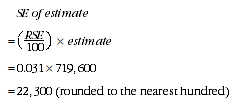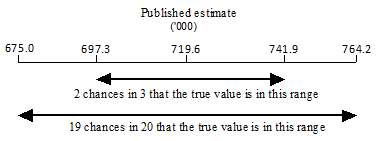TECHNICAL NOTE DATA QUALITY
RELIABILITY OF ESTIMATES
1 Since the estimates in this publication are based on information obtained from occupants of a sample of dwellings, they are subject to sampling error. That is, they may differ from those that would have been produced if all dwellings had been enumerated in the survey. One measure of the likely difference is given by the standard error (SE), which indicates the extent to which an estimate might have varied by chance because only a sample of dwellings was included. There are about two chances in three (67%) that a sample estimate will differ by less than one SE from the population parameter that would have been obtained if all dwellings had been enumerated, and about 19 chances in 20 (95%) that the difference will be less than two SEs.
2 Another measure of the likely difference is the relative standard error (RSE), which is obtained by expressing the SE as a percentage of the estimate:

3 Space does not allow for the separate indication of the SEs and RSEs of all the estimates in this publication. However, RSEs were calculated for each separate estimate and are available to download free-of-charge as Excel spreadsheets from the ABS website <www.abs.gov.au> as an attachment to this publication. The Jackknife method of variance estimation is used to calculate SEs, which involves the calculation of 30 replicate estimates based on 30 different sub samples of the original sample. The variability of estimates obtained from these sub samples is used to estimate the sample variability surrounding the main estimate.
4 In the tables in this publication, only estimates (counts or proportions) with RSEs less than 25% are considered sufficiently reliable for most purposes. However, estimates with larger RSEs have been included and are preceded by an asterisk (e.g. *3.4) to indicate that they are subject to high SEs relative to their estimate and should be used with caution. Estimates with RSEs greater than 50% are preceded by a double asterisk (e.g. **2.1) to indicate that they are considered too unreliable for general use.
CALCULATING STANDARD ERRORS FOR POPULATION ESTIMATES
5 Standard errors can be calculated using the estimates (count or proportions) and their corresponding RSEs. For example, Table 1 shows the estimated number of persons who were recent migrants as at November 2010 is 719,600. The RSE table for Table 1, with the RSEs corresponding to the estimates in Table 1, is included at the end of these Technical Notes. This shows the RSE for the estimate is 3.1%. The SE is:

6 Therefore there are about two chances in three that the population count that would have been obtained if all dwellings had been enumerated in the survey would fall in the range 697,300 to 741,900 and about 19 chances in 20 that the population count would fall within the range 675,000 to 764,200. This example is illustrated below:

The difference between two survey estimates (numbers or proportions) is also subject to sampling error. The sampling error of the difference between two estimates depends on their SEs and the relationship (correlation) between them. An approximate SE of the difference between two estimates (x-y) may be calculated by the formula:
![Equation: SE(x - y) = square root ([SE(x)] squared + [SE(y)] squared)](/AUSSTATS/abs@.nsf/7d12b0f6763c78caca257061001cc588/cf3ed7dbcd7e9943ca257d04001298b5/Body/0.27CE!OpenElement&FieldElemFormat=gif) 8
8 While this formula will only be exact for differences between separate and uncorrelated (unrelated) characteristics of sub-populations it is expected to provide a good approximation for all differences likely to be of interest in this publication.
SIGNIFICANCE TESTING
9 The statistical significance test for any of the comparisons between estimates was performed to determine whether it is likely that there is a difference between the corresponding population characteristics. The standard error of the difference between two corresponding estimates (x and y) can be calculated using the formula in paragraph 7. This standard error is then used to calculate the following test statistic:
 10
10 If the value of this test statistic is greater than 1.96 then there is good evidence of a real difference in the two populations with respect to that characteristic. This statistics corresponds to the 95% confidence interval. Otherwise, it cannot be stated with confidence that there is a real difference between the populations.
RELATIVE STANDARD ERROR
11 Relative Standard Errors for Table 1 are included below. However, RSEs for all tables are available free-of-charge on the ABS website <
www.abs.gov.au>, released in spreadsheet format as an attachment to this publication.
Table 1 RSEs:All persons aged 15 years and over, Migration status as at November 2010 and 2007 - By sex |
|
 |  |  |  |  |  |  | Males | Females | Persons | Proportion of all persons |
 |  |  |  |  |  |  | % | % | % | % |
2010 |
|
| Born in Australia(a) | 0.5 | 0.6 | 0.5 | 0.5 |
| Born overseas | 1.1 | 1.5 | 1.2 | 1.1 |
 | Arrived before 2001 | 1.3 | 1.6 | 1.3 | 1.2 |
 | Arrived after 2000 | 2.5 | 2.9 | 2.4 | 2.4 |
 |  | Aged less than 15 years on arrival | 8.4 | 12.0 | 8.4 | 8.5 |
 |  | Aged 15 years and over on arrival | 2.7 | 2.9 | 2.5 | 2.5 |
 |  |  | Recent migrants and temporary residents | 3.1 | 3.2 | 2.7 | 2.7 |
 |  |  |  | Recent migrants | 3.4 | 3.9 | 3.1 | 3.1 |
 |  |  |  |  | Australian citizen | 5.2 | 5.8 | 4.7 | 4.7 |
 |  |  |  |  | Permanent | 5.1 | 4.8 | 4.1 | 4.1 |
 |  |  |  |  |  | Skilled | 6.6 | 7.6 | 6.0 | 6.0 |
 |  |  |  |  |  | Family | 9.7 | 7.6 | 6.7 | 6.7 |
 |  |  |  |  |  | Humanitarian | 27.0 | 23.9 | 21.7 | 21.7 |
 |  |  |  |  |  | Other/n.f.d. | 21.3 | 19.0 | 14.2 | 14.2 |
 |  |  |  | Temporary residents | 4.8 | 5.2 | 4.5 | 4.5 |
 |  |  |  |  | Student | 7.5 | 8.9 | 7.3 | 7.3 |
 |  |  |  |  | Other/n.f.d. | 6.5 | 7.6 | 6.1 | 6.1 |
 |  |  |  | Status not determined | 26.9 | 28.2 | 17.5 | 17.6 |
 |  |  | Australian/New Zealand citizen before arrival or currently holds New Zealand citizenship | 8.6 | 7.8 | 7.0 | 7.0 |
 |  |  |  | Born in New Zealand | 10.6 | 8.9 | 8.7 | 8.7 |
 |  |  |  | Not born in New Zealand | 13.6 | 16.1 | 12.2 | 12.1 |
 |  |  | Planning to stay less than 12 months | 31.0 | 35.0 | 25.8 | 25.7 |
| Total | 0.2 | 0.3 | 0.2 | - |
2007 |
|
| Born in Australia(a) | 0.5 | 0.5 | 0.4 | 0.4 |
| Born overseas | 1.4 | 1.3 | 1.2 | 1.2 |
 | Arrived before 1998 | 1.2 | 1.5 | 1.2 | 1.2 |
 | Arrived after 1997 | 3.3 | 2.8 | 2.7 | 2.7 |
 |  | Aged less than 15 years on arrival | 12.3 | 11.3 | 9.0 | 9.0 |
 |  | Aged 15 years and over on arrival | 3.1 | 2.8 | 2.6 | 2.6 |
 |  |  | Recent migrants and temporary residents | 3.7 | 2.9 | 2.7 | 2.7 |
 |  |  |  | Recent migrants | 4.1 | 3.5 | 3.3 | 3.3 |
 |  |  |  |  | Australian citizen | 6.3 | 4.2 | 4.2 | 4.2 |
 |  |  |  |  | Permanent | 4.4 | 4.8 | 3.9 | 3.9 |
 |  |  |  |  |  | Skilled | 7.5 | 7.4 | 6.6 | 6.6 |
 |  |  |  |  |  | Family | 7.7 | 8.5 | 6.5 | 6.5 |
 |  |  |  |  |  | Humanitarian | 22.7 | 29.2 | 21.8 | 21.8 |
 |  |  |  |  |  | Other/n.f.d. | 31.8 | 29.8 | 20.7 | 20.7 |
 |  |  |  | Temporary residents | 7.2 | 7.3 | 6.5 | 6.5 |
 |  |  |  |  | Student | 11.1 | 11.5 | 10.2 | 10.2 |
 |  |  |  |  | Other/n.f.d. | 7.2 | 7.7 | 5.5 | 5.5 |
 |  |  |  | Status not determined | 58.9 | 49.8 | 51.2 | 51.2 |
 |  |  | Australian/New Zealand citizen before arrival, currently holds New Zealand citizenship or born in New Zealand | 7.7 | 7.8 | 7.3 | 7.3 |
 |  |  |  | Born in New Zealand | 8.9 | 7.7 | 7.4 | 7.4 |
 |  |  |  | Not born in New Zealand | 13.2 | 17.1 | 13.9 | 13.9 |
 |  |  | Planning to stay less than 12 months | 36.0 | 28.9 | 25.5 | 25.5 |
| Total | 0.2 | 0.3 | 0.3 | 0.3 |
|
| - nil or rounded to zero (including null cells) |
| (a) Includes External Territories. |
 Print Page
Print Page
 Print All
Print All
 Quality Declaration
Quality Declaration